| Literary Workers of the South | ||
LITERARY WORKERS OF THE SOUTH.
The remarkable development of literary activity in the South, the men
and women who have taken leading places in the movement, and their
especially important contribution to the American fiction of the
day.
UNTIL a comparatively recent date, there were almost no men and
women in the South who made a profession of literature. Before the
war, there was here and there a man who amused himself by writing a
book. William Gilmore Simms, indeed, was a professed literary man; so
was Poe, but he left the South early in his career. The books of John
Pendleton Kennedy, secretary of the navy under Fillmore,
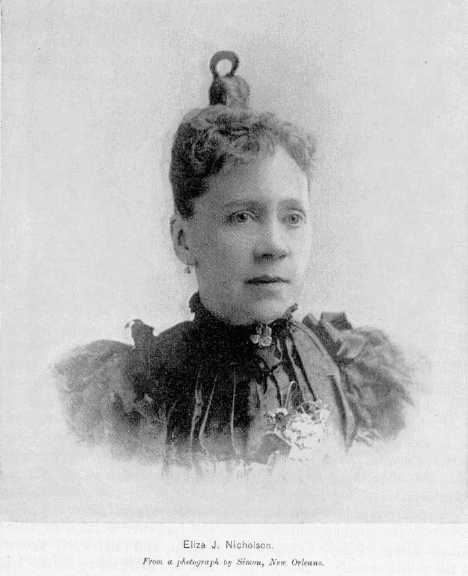
Eliza J. Nicholson.
[Description: A portrait of Eliza J. Nicholson, from a photograph by Simon
of New Orleans]
From a photograph by Simon, New
Orleans.
It is the men and women who inherited this talent, along with
the old letters, who are telling their stories today.
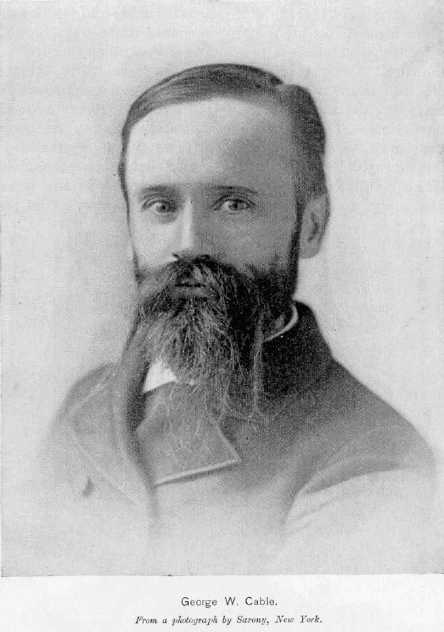
George W. Cable.
[Description: A portrait of George W. Cable, from a photograph by Sarony
of New York]
From a photograph by Sarony, New
York.
Miss Grace King of New Orleans illustrates the point exactly. She tells a story of the Crescent City with such subtle building up of detail, such humor, such delineation of characters peculiar to the South, that New Orleans people can never be made to believe that the Northerner ever really understands them. She had told stories for years, never thinking of her gift as anything more than as an amusement for her friends. One night, at a dinner party, her host was entertaining Charles Dudley Warner, and Miss King sat near him. In the course of conversation she told a pathetic little tale of the devotion of an old negress to a white child. It astonished and delighted Mr. Warner, who asked Miss King if she had ever written anything for publication, and offered, if she would write out her little story as she had told it to
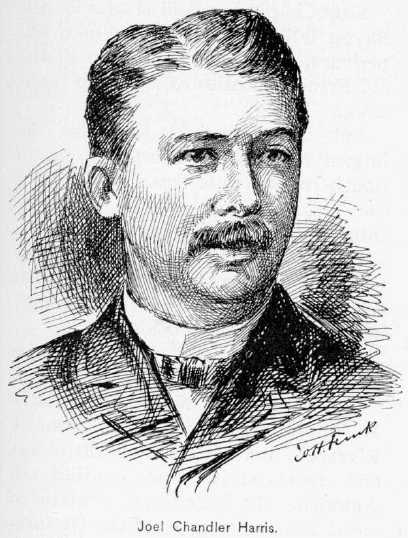
Joel Chandler Harris.
[Description: A portrait of Joel Chandler Harris, drawn in ink.]Miss King was educated among the Creoles, although she belonged to a Georgia family. Her father was a prominent lawyer in New Orleans, and it was his encouragement that developed the story telling gift of which she has made so much.
George W. Cable is usually considered the historian of New Orleans, and he has made the North accept him as such, although his native city declines to give him that honor. It may be the strain of Puritan blood, coming to him through his New England mother, that keeps him from drawing the Creole with that touch of entire sympathy which makes Grace King's stories loved by the people she depicts.
Cable is entirely a self made man. He was compelled to earn his own living from childhood. As a boy, he was very studious and deeply religious, devoting all his spare time to the study of Latin and the Bible. At eighteen he enlisted, and for two years served in the Confederate army. Then he accepted a position on one of the New Orleans papers, but he resigned because he was asked to report the theatrical news. At this time he had conscientious scruples against novel reading. After leaving the paper and going to work in a cotton house, he wrote the first chapters of "The Grandissimes"—a book that deserves to be known as an American classic.
Mr. Cable's stories of New Orleans are his best work. His latest book, "John March, Southerner," has not the clearness of atmosphere, the subtle charm, that gives his earlier fiction its peculiar value. He sees so much unused material in the South that he cannot let it alone, although he has left New Orleans, and for several years has lived in Massachusetts.
Another New Orleans writer, Mrs. M. E. M. Davis, the wife of one
of the editors of the Picayune, has given the most perfect
picture ever written of plantation life during the war in her
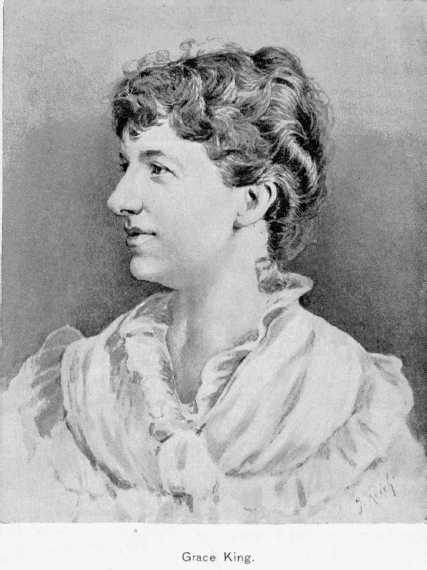
Grace King.
[Description: A portrait of Grace King.]
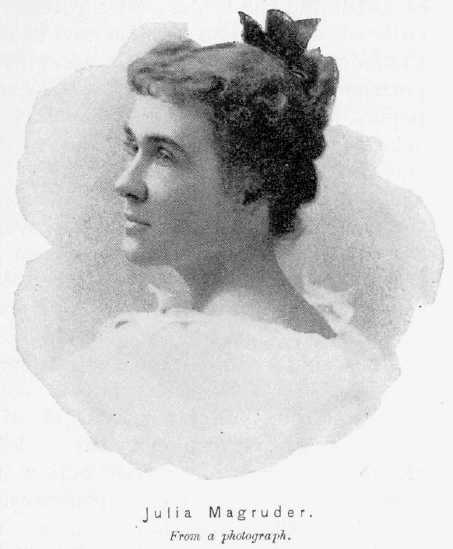
Julia Magruder.
From a photograph.
[Description: A portrait of Julia Magruder, from a photograph.]
Mrs. E. J. Nicholson, the owner of the Picayune, and its editorial chief, combines in a remarkable way the qualities of a genuine poetess and of a successful business woman. She was Miss Eliza Poitevent, the daughter of an old Huguenot family, and her childhood was spent on the Pearl River, from which she has taken the rather romantic pseudonym of "Pearl Rivers." While still a young girl she joined the staff of the Picayune as literary editor, shortly afterward marrying the owner, Colonel Holbrook. Finding herself, at his death, in possession of a political paper heavily burdened with debt, she succeeded in bringing it to a firm place among the newspapers of the country. Her marriage to Mr. Nicholson, who is the business manager of the Picayune, has given her leisure for literary work and for brilliant social life.
Kate Chopin has told stories of the Bayou folk, taken from her own experience. She belongs to one of the old French families of southern Louisiana.
But it is Virginia that has the largest representation in the class of Southern story tellers. More than one Virginian has sprung, not only into notice, but into fame, through a single story. They have come, not as the work of prentice hands, but with the finish of professional handling, and with entirely new ideas.
Three of the best known of the Virginia writers are cousins,
after a fashion. Thomas Nelson Page, Miss M. G. McClelland, and Mrs.
Amélie Rives Chanler, all belong to the oldest and most
aristocratic families in America. Mr. Page is a descendant of General
Nelson, a signer of the Declaration. He was born in 1853 at Oaklands,
the old home situated at the meeting of the roads leading to Richmond,
which were to be the great highways of two armies a few years later.
In one of his
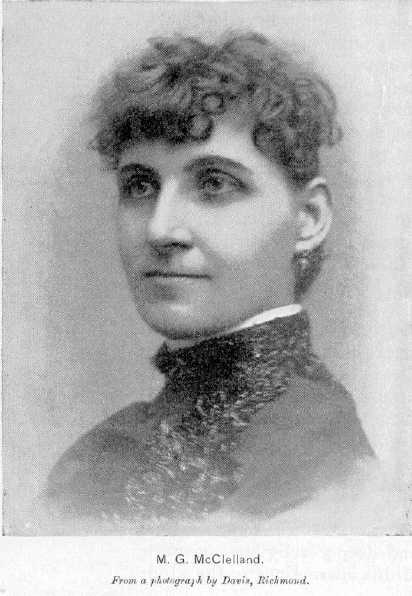
M. G. McClelland.
[Description: A portrait of M. G. McClelland, from a photograph by Davis
of Richmond.]
From a photograph by Davis, Richmond.
After the appearance of "Marse Chan"—which was written several
years before it was published—Mr. Page
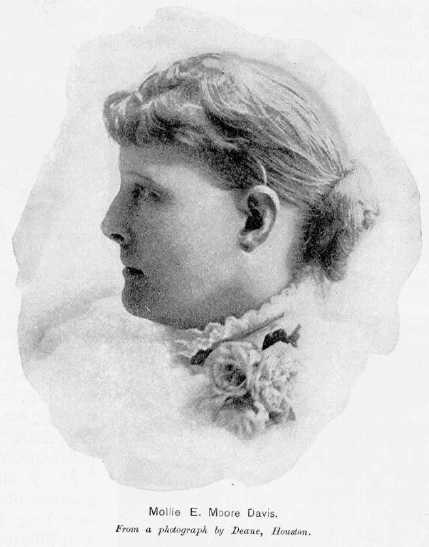
Mollie E. Moore Davis.
[Description: A portrait of Mollie E. Moore Davis, from a photograph by Deane
of Houston.]
From a photograph by Deane, Houston.
Unfortunately, this still remains the best work of its author. Her next lot of stories were fairly good, and then she wrote "The Quick or the Dead." To-day, that brief novel might attract attention, and it might not. It was the first in the list of hysterical stories, to which "A Yellow Aster," "A Superfluous Woman," and dozens of others belong. Its author originated the type in this country; but compared with its companions her novel is mild, indeed.
Miss Rives married Mr. John Armstrong Chanler, a well known member of the Astor family, and has since spent much of her time abroad, living for a time in Madame de Pompadour's chateau in France.
Miss M. G. McClelland, like her cousin, never went to school, but for a different reason. The war brought reverses to the family, and she was educated entirely by her parents. Her mother was the daughter of a German
Miss Julia Magruder is another Virginia girl who has written
several entertaining stories. "Across the Chasm" was her greatest
success, and it owed much of its popularity to its delicate humor.
But in humor, no woman and few men have surpassed Frances Courtenay
Baylor. Every Baylor is a Virginian, wherever born, and it was a mere
accident which made Arkansas
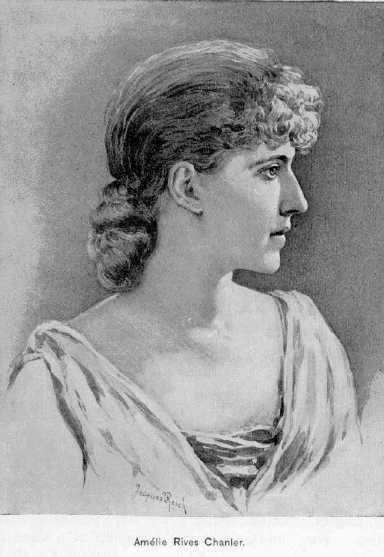
Amélie Rives Chanler.
[Description: A portrait of Amélie Rives Chanler.]
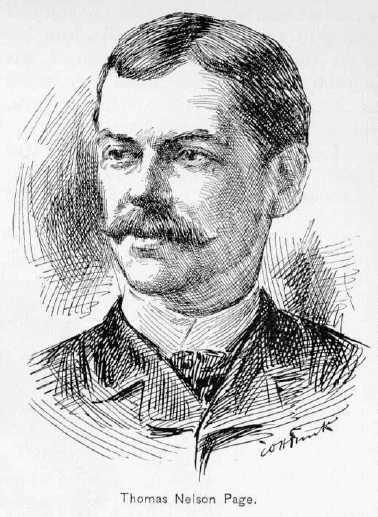
Thomas Nelson Page.
[Description: A portrait of Thomas Nelson Page, drawn in ink.]
Molly Elliot Seawell is another of the descendants of a long line of dignified Virginia ancestors, and she too shows how good a training it is for a girl of that race to be turned loose in a library. The Seawells came from Gloucester County, in lower Virginia. Her grandmother was a sister of President Tyler, and Henry A. Wise says, in "The Seven Decades of the Union," that "the women of this family have always been remarkable for their strength of character and beauty of person." It may have been for this reason that Miss Seawell dared to stir up such a
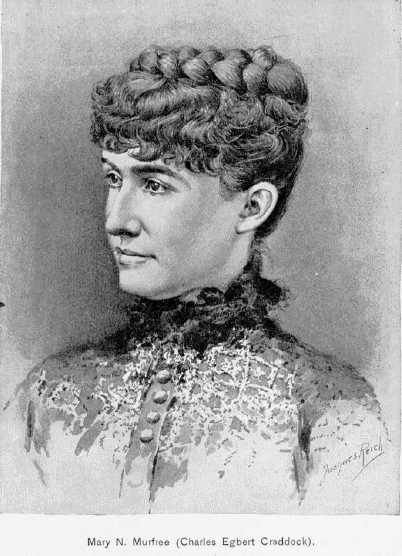
Mary N. Murfree (Charles Egbert Craddock).
[Description: A portrait of Mary N. Murfree, bu Charles Egbert Craddock.]Miss Seawell wrote under several names before she produced something that she considered worthy to go over her own signature. This "something" was her celebrated short story "Maid Marian," which was dramatized for Rosina Vokes, and was the last new play she acted. Another comedy of Miss Seawell's, "Uncle Maurice," is to be put on the stage by Frederick Bond next season. Her near neighbor and intimate friend, at her present home in Washington, is Mrs. Frances Hodgson Burnett; and, like the latter, she has made essays into juvenile literature, turning out two delightful naval stories for boys.
Miss Seawell might have written her stories from anywhere, but that is not true of the greatest woman writer in the South, Miss Mary Murfree, who is best known as Charles Egbert Craddock. Her work was published by a well known Boston editor for several years before he discovered that she was not a man. Her handwriting is very heavy and black, and it was Mr. Thomas Bailey Aldrich's joke to say, "I wonder if Craddock has taken in his winter supply of ink, and can let me have a serial." One day a card came to Mr. Aldrich bearing the well known name in the well known writing, and the editor rushed out to greet his old contributor, expecting to see a sturdy Tennessee mountaineer. When a slight, delicate little woman arose to answer his greeting, it is said that Mr. Aldrich
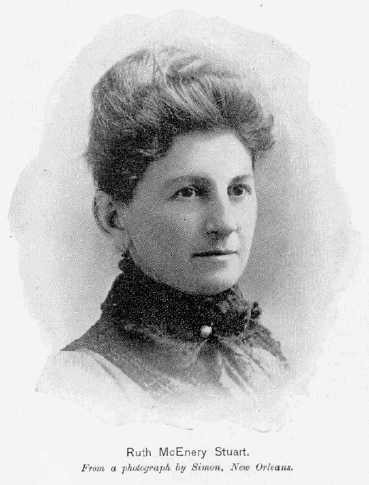
Ruth McEnery Stuart.
From a photograph by Simon, New
Orleans.
[Description: A portrait of Ruth McEnery Stuart, from a photograph by Simon
of New Orleans]
Murfreesboro, Tennessee, was named after Miss Murfree's great grandfather, Major Hardy Murfree. The old homestead of the family is described in "Where the Battle Was Fought." It is her delineations of mountain character, and her descriptions of mountain scenery, that have placed her work in the place it holds. Her style is bold, full of humor, and yet as delicate as a bit of lace. To Mary Wilkins' gift of giving exact pictures of homely life, Miss Murfree unites great power of plot and a keen wit. The little old woman who sits on the edge of a chair in one of her novels, has added stores to America's proverbs. "There ain't nothin' so becomin' to a fool as a shet mouth," has taken its place with its older kindred.
There is another woman whose vein of humor has just begun to show itself. Ruth McEnery Stuart is a Louisiana woman who has come to New York within the past few years with a stock of stories which the public would like to keep her busy reading aloud to them. "The Widder Johnsing" is about the best and truest picture of darky life that has been drawn.
But the humorists of the South have generally been men. Richard
Malcolm Johnston and Joel Chandler Harris are the best known today.
Mr. Harris is "Uncle Remus" to the whole world. His tales of the wily
Brer Rabbit and his more or less dissolute companions of the
field belong to the English language, having found their way into book
shops in China and Calcutta. Mr. Harris is a Georgia newspaper man
who learned to set type when he was fourteen, and who has been for
many years on the staff of the Atlanta Constitution.
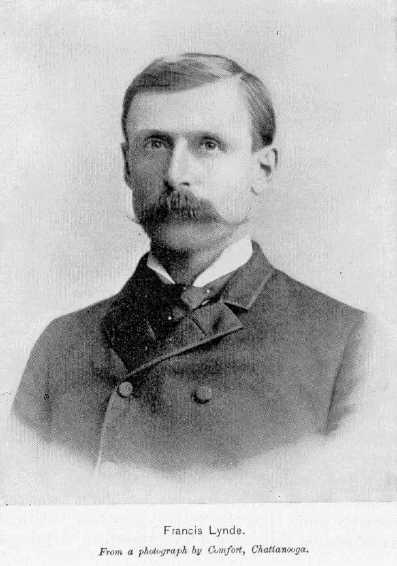
Francis Lynde.
[Description: A portrait of Francis Lynde, from a photograph by Comfort
of Chattanooga.]
From a photograph by Comfort, Chattanooga.
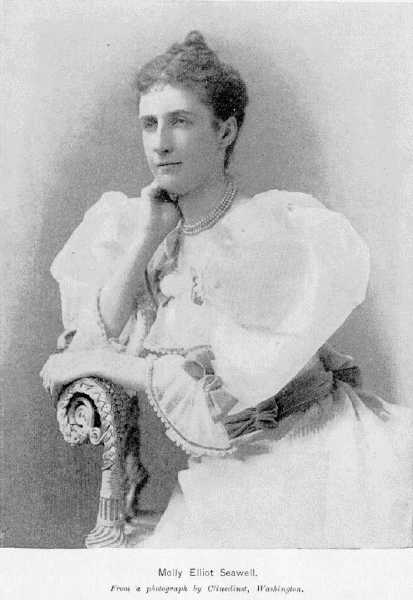
Molly Elliott Seawell.
From a photograph by Clinesdinst,
Washington.
[Description: A portrait of Molly Elliott Seawell, from a photograph by
Clinesdinst of Washington.]
Harry S. Edwards, of Macon, Georgia, is another newspaper man who has written stories of Southern life which are full of color and humor.
Young as Richard Malcolm Johnston's stories are, he celebrated his golden wedding at his home in Baltimore last year. Colonel Johnston was born in the middle Georgia the readers of his stories know so well. Like most Southern gentlemen of that day, he studied law, and practised for ten years. At the end of that time he was offered three positions—a judgeship, the presidency of Mercer University, and a professorship in the State University. He chose the latter. In his old age he is a well known figure in Baltimore.
James Lane Allen is an author of scholarly and original fiction. He was a professor in a Kentucky college when he first began writing. "The White Cowl" and "Sister Dolorosa" are tales of convent life in Kentucky. Their subject matter was a revelation to many people, and one that will not soon be forgotten.
Francis Lynde, whose faithful and dramatic pictures of Southern and Western life are beginning to attract the attention of the critics, lives in Chattanooga: but he is a Southerner only by adoption, being the son of Canadian parents. His knowledge of the scenes and characters he depicts is drawn from the practical experiences of a busy career.
Every year, almost, adds a new name to the South's list of literary workers.
Anna Leach.
| Literary Workers of the South | ||